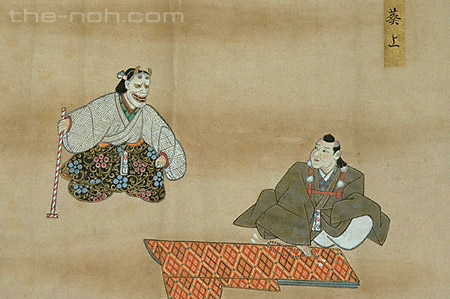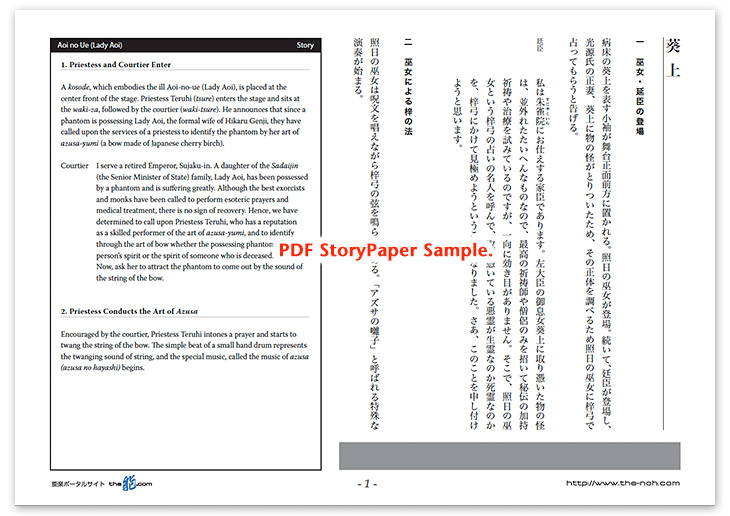
 Aoi no Ue (Lady Aoi)
Aoi no Ue (Lady Aoi)

![]()
Aoi-no-ue (Lady Aoi), the formal wife of Hikaru Genji and a daughter of the Sadaijin (the Senior Minister of State) family, has been possessed by a phantom and seriously ill. Although her family has tried various cures to help her recover, nothing has worked. In order to clarify the identity of the phantom, they have finally decided to invite Priestess Teruhi, master of the art of azusa, which calls forth phantoms with the sound of a bow made of Japanese cherry birch (azusa-yumi).
The phantom, who is trapped by the priestess's prayer and appears, is the vengeful spirit of Rokujō-no-miyasudokoro (Lady Rokujō), the wife of a deceased crown prince and a lover of Genji. Rokujō is a very sophisticated noble lady. However she has recently lost Genji's attention and is rarely visited. Furthermore, she lost a contest for precedence to Genji's wife Lady Aoi, when her carriage was pushed aside at the time of Kamo Festival, when she secretly went out to see Genji in the festival parade. The spirit of Lady Rokujō thus complains of her growing agony, which can go nowhere. Looking at Lady Aoi, she is torn by jealousy and beats Aoi to take her soul out, just as a wife hates and beats her husband's young lover.
The subjects of the Sadaijin family are awed by the fury of Lady Rokujō and rush to invite a priest, Yokawa-no-kohijiri, who is a powerful practitioner of Shugen-dō. When the priest starts a sacred invocation, the jealousy in Lady Rokujō's heart embodies itself as a female ogre. Turned out to be an enmity personified, Lady Rokujō assaults not only Lady Aoi but also the praying priest. After a bitter fight, the vengeful phantom of Lady Rokujō was overcome and calm down. Lady Rokujō's spirit became peaceful and capable of becoming a Buddha.
![]()
Although the title of this drama is "Aoi-no-ue (Lady Aoi)," the lady herself does not appear on the stage. A kosode is placed at the center front of the stage to embody Lady Aoi, who is suffering from the phantom without resistance. The core of this drama is the affection and jealousy of Lady Rokujō, who cannot help being an ogre. Since she is an ex-crown princess, the actor needs to express dignity in her eerie spirit even after she is transformed into an ogre. At the ending of maeba, she throws a fan and disappears while covering herself with a kimono. Particularly, in this scene, the actor has to express her emotional upsurge while moving gracefully to maintain her dignity.
This drama involves various devices to nurture the atmosphere of the Tale of Genji. The climax of utai in the first half of the drama includes names of the chapters of the Tale of Genji. Also, in the Muromachi era people felt that the direct cause of Lady Rokujō's jealous struggle with Lady Aoi was that she lost the fight for precedence for her carriage against Lady Aoi at the Kamo Festival. Following this interpretation, Lady Rokujō enters the stage riding on a broken carriage in the first half of the drama.
STORY PAPER : Aoi no Ue (Lady Aoi)
Story Paper presents noh chant stories in modern speech, with story outlines, highlights and more using Adobe PDF format, which can print out and zoom in. Print out the pages and take them with you when you see the actual noh performance.

The copyright of Story Paper is held by the Noh.com. Story Paper is for individual use only. It is prohibited by the copyright law to distribute or publish printed-out Story Paper pages without prior consent. For more information, check the credit and disclaimer pages.



 [Aoi no Ue (Lady Aoi) : Story Paper PDF : 607KB
[Aoi no Ue (Lady Aoi) : Story Paper PDF : 607KB